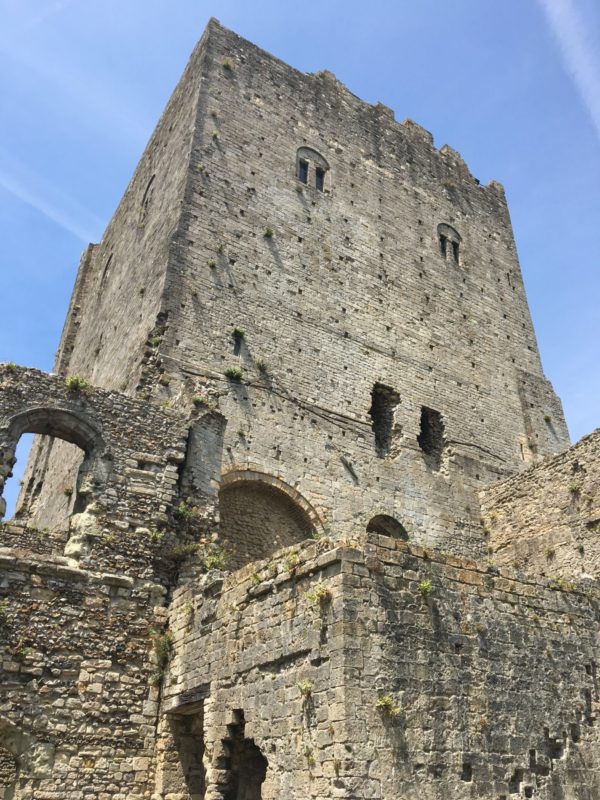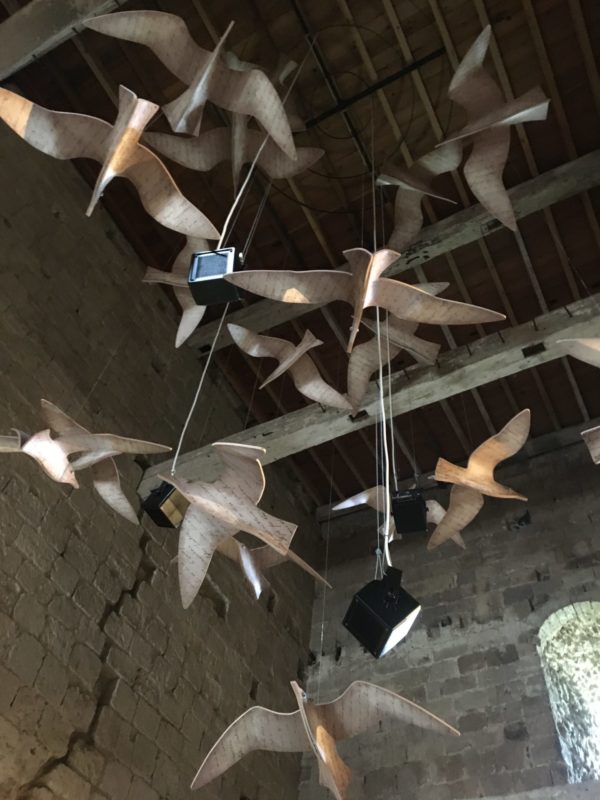Les Murs Sont Témoins | “These Walls Bear Witness” at Portchester Castle
29 October 2019 – Katherine Astbury and Abigail Coppins
prisoners of war, archives, slavery, incarceration, artists, theater, 2019 archives month series, sound
Editors’ Note: This is one in a series of posts about the intersection of archives and public history that will be published throughout October, or Archives Month in the United States. This series is edited by National Council on Public History (NCPH) board member Krista McCracken, History@Work affiliate editor Kristin O’Brassill-Kulfan, and NCPH The Public Historian co-editor/Digital Media Editor Nicole Belolan.
The twelfth-century Portchester Castle on the English south coast held thousands of French prisoners of war during the French Revolutionary and Napoleonic campaigns of the late eighteenth and early nineteenth centuries, most notably over 2,000 black revolutionaries and their families from the Caribbean. Internationally renowned sound artist and musician Elaine Mitchener worked with researchers from the University of Warwick to bring some of the remarkable stories of the prisoners of war to life through a sound installation housed in the castle’s keep for six months in 2019. This post explores how that collaboration worked and the ways in which archival materials were brought into dialogue with the physical spaces in which the prisoners of war were held.

Many of prisoners-of-war from the Caribbean were incarcerated in Portchester Castle’s twelfth-century keep. Photo credit: Katherine Astbury
Prisoners of war are considered a phenomenon of the large-scale wars of the twentieth century. But during the Revolutionary Wars with France (1793-1802) and the campaigns against Napoleonic France (1803-1815), Britain witnessed a surge in the numbers of prisoners of war being brought to the country. The prisoners were housed in existing prisons or purpose-built locations, such as Dartmoor, or incarcerated in repurposed buildings such as Portchester Castle.
Portchester had two main waves of prisoners, the first in 1796-97 when prisoners of war from the Caribbean arrived, and the second in 1810 when Napoleonic army conscripts captured by the Spanish were shipped to Britain. The lives, identities, and race of the prisoners received little attention before 2017 when English Heritage, who manages the site at Portchester, unveiled a new exhibition in the keep on the castle as a prisoner-of-war depot. The research for the 2017 reinterpretation was conducted by curator Abigail Coppins, whose work focused on the 2,000 black revolutionaries, and by academics from the University of Warwick, Professor Katherine Astbury and PhD student Devon Cox, who were funded by the UK’s Arts and Humanities Research Council to look at the French Theatre built by Parisian prisoners on the ground floor of the keep in 1810.
The 2017 interpretation included a recreated theatre and costumes for the dressing-up box inspired by photographic prints of costumes from performances that the prisoners would have seen in Paris before they were conscripted. The space also included information panels and audio recordings of letters and reports about the conditions and daily lives of the prisoners. A performance of a three-act melodrama, Roseliska, written and performed by the prisoners of war in 1810, marked the launch of the new permanent exhibition. The melodrama was performed by a cast from Past Pleasures, the UK’s oldest professional costumed interpretation company and freelance professional musicians. The melodrama manuscript had survived in papers belonging to the commander of the prison, Captain Charles Paterson, which were deposited in the Victoria & Albert Museum theatre collection in 2011.
There are very few surviving scripts from full-length POW plays of the Napoleonic period. A second, Le Philantrope révolutionnaire ou Hécatombe à Haiti [The Revolutionary philanthropist], first performed in 1807 on board one of the prison hulks out in the bay and copied in 1811, is held in the archives at the University of California, Berkeley. This manuscript script would be the catalyst for the sound installation at Portchester Castle. Written from the perspective of the white colonists, it is nevertheless unusual for an early, written eyewitness account of the slave uprising in Haiti in 1793 because it gives voice to the slaves. For instance, the leader of the rebel army in the woods, Spartacus, rallies his troops with the rejoinder: ‘Songez à l’état de dégradation dans lequel vous gémissez, et ne voyez dans l’avenir que la perspective d’une indépendance qu’il ne sera plus au pouvoir des blancs de ravir’ [Remember the humiliating state you are forced to endure, see nothing in your future but your independence, an independence that the whites will never be able to seize back]. The play explores the fear of change and of violence at the heart of individual responses to revolution and questions of what it means to be free. It was also a point of intersection between the exhibition panels on the black revolutionaries who were at Portchester in 1796-97 and the theatre-performing prisoners of the following decade.
Abigail Coppins and I approached acclaimed vocal artist Elaine Mitchener, whose work, SWEET TOOTH, had recently completed a UK tour. SWEET TOOTH uses sound art and live performances to explore the legacies of the slave trade of sugar between the UK and the Caribbean. It included a chapter entitled “Names” inspired by an 1813 inventory of slaves held in the Jamaica Archives in Spanish Town, Jamaica, and transcribed by Dr. Christer Petley (University of Southampton). We felt that with this experience of turning archives into art, Elaine would be the ideal artist to create a piece of art to help the castle walls bear witness to this period of historic interest and in so doing explore what slavery means in Britain today.
The installation was designed for the walls to “talk” and bring the stories of the individuals housed at Portchester more clearly into focus. The installation uses extracts from the play Le Philantrope révolutionnaire ou Hécatombe à Haiti, the entry registers of prisoners’ names held in the UK National Archives, and letters from and about some of the women who were among the revolutionaries brought from St Lucia and St Vincent in 1796-97. Visitors are not bombarded with the recordings as background noise but have to seek out the recordings in nooks and crannies because Elaine wanted visitors to have to listen actively rather than passively. This did pose problems for the hard of hearing, particularly when the castle was busy and, in hindsight, it would have been good to have had a digital version available via an app so that individuals could adjust the volume themselves. Much of the archival material was recorded in the original French as well as in English translation with French Caribbean accents. It was important for visitors to have a direct experience of the sounds of the French language in a space now seen as quintessentially part of British heritage as it serves as a powerful reminder of global encounters and interactions taking place during the Age of Revolutions. In her programme notes to the installation, Elaine explained her concept for it: “I wanted to create a piece which shows that under the most challenging circumstances humankind has the ability to maintain their humanity in creative ways. This exhibition attempts to draw visitors into the physical space and, through sound, engage with it in a focussed and intimate way.”

Speakers for the sound installation hanging amongst seagulls from the permanent exhibition. Photo credit: Katherine Astbury
At the heart of the installation lay fundamental questions about human rights, discrimination, identity, and the power of culture to overcome national differences. The lives of the black prisoners allow us to move beyond traditional narratives of the enslaved as victims to celebrating black agency: they were revolutionaries who actively opposed the British, their actions paved the way for emancipation and abolition. The installation touches on issues as much of relevance today as back then and brings visitors into contact with archival material such as letters, registers, and play texts in a much more immediate way than if these documents had been reproduced in facsimile or transcribed and presented on a panel.
By using the castle keep’s architecture to full advantage, the sound installation has brought visitors closer to the experiences of those held at Portchester over 200 years ago: a speaker in the internal well allows music to be heard in the theatre; standing in one of the medieval fireplaces brings a speech about freedom into earshot, Gwo Ka drumming brings rhythm to the rooms. The archival material has gained relevance and an immediacy in the ways in which it reverberates around the stone walls. We are now looking to export the installation to other spaces connected to the prisoners in France where they were sent on release from Portchester and in the Caribbean to where many of them returned to continue the struggle for emancipation and political freedom. As researchers, it has led us to see the archival material in a new light. It has provided a stimulus for school pupils to create their own artistic works on the prisoners and feedback from visitors has confirmed that “it added real, immersive value, and showed a unique perspective to the castle’s history.”
~Katherine Astbury is Professor of French Studies at the University of Warwick. Her research focuses French culture 1750-1815 and the ways in which cultural forms inflect the public sphere and shape political legitimacy.
~Abigail Coppins is a public historian and archaeologist in the UK and is pursuing a Ph.D. in French Studies at the University of Warwick. She has worked as a curator and researcher for English Heritage and has produced exhibitions at Portchester Castle and Stonehenge.



